16 Scenes From Ingram-Micro VTN: The Power Of Partnering

Ingram Micro held its Tenth Annual VentureTech Network Fall Invitational at the San Diego Marriott Hotel and Marina earlier this month.
The distributor used the meeting to help its VTN members learn new ways to work together. It paraded several solution providers on-stage to discuss how they have benefited from partnering with their peers, as well as other aspects of running a successful business.
Ingram Micro also brought in outside entertainers and speakers as well, including a local percussion ensemble (pictured), and a former P.O.W. from the Vietnam War who talked about his experience as a prisoner in the Hanoi Hilton with John McCain and how it helped him shape his decision-making process.

The conference officially opened Wednesday afternoon, Oct. 15, with a performance by a local percussion ensemble which featured a mix of "Stomp"-inspired garbage can rhythm and "Drumline"-inspired drumming.
The performance, which included a couple of solution providers being pulled on-stage to make drum and cymbal noises with their mouths, helped wake up any VTN members who might have made sleepy earlier in the day with pre-opening training and marketing sessions.
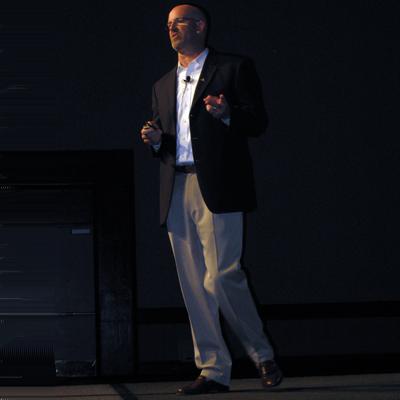
Kirk Robinson, vice president of channel marketing for Ingram Micro North America, officially opened the conference by telling solution providers they need to not only look for business opportunities, but also to work together to capitalize on those opportunities.
During the current economic downturn, solution providers need to shore up their business against risk, aggressively pursue their target markets, and create solutions instead of selling products, Robinson said.
The most successful solution providers will be those who collaborate in order to take advantage of each other's talent, expertise, and vision, Robinson said.
"There is so much brainpower in this community," he said. "We can accomplish whatever we want. But it's going to take sharing."
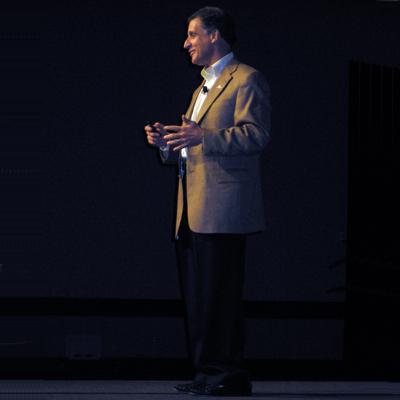
Frank Vitagliano, senior vice president of worldwide channels at Juniper Networks, returned to the VTN stage for the first time since he left his channel chief role at IBM to move to Juniper about three years ago.
Vitagliano started by complaining that a couple of solution providers such as Steve Harper, president of NMGI, of Hutchinson, Kansas, have never bought anything from whichever company he has worked for.
He said that Juniper is a trusted partner company, one that does not compete with its partners, with a product around which partners can build their own solutions and services.

Vitagliano also got a big laugh when he pulled up a slide he used three years ago while at IBM titled, "VTN Value Proposition to IBM." He crossed out the word "IBM" and substituted "Juniper," and said that he wants to provide the same service and value to VTN members that he did when was at IBM.

Robinson next introduced the newly-elected co-presidents of VTN, JoeAnne Hardy, president of WBM Office Systems, of Calgary, Alberta; and Greg Starr, partner and COO of I.T. Works, of Texarkana, Texas.
Asked to dress in their native costumes for their initial appearance, Hardy came on-stage with a warm cap and snow boots, while Starr sported the latest in cowboy hats and boots. Both added a San Diego touch to their ensembles.
Hardy told her peers in the audience to take every advantage of the opportunities presented in a gathering of solution providers. "As business people, we can't just open our doors and carry on," she said. "We have to constantly invest in education."
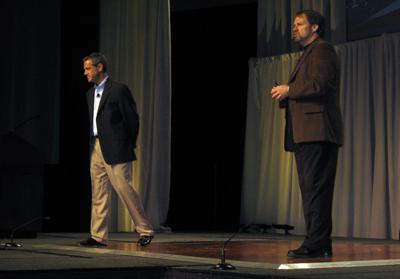
A couple of other VTN members -- Ted Warner, president of Connecting Point of Greeley, Greeley, Colo., and Peter McMahon, vice president of sales at Protek Systems, London, Ont. -- updated solution providers on the VentureTech Leader Alumni Network.
McMahon (right) said that VLAN is working on the newest financial benchmarking report, and has simplified the profit survey report by making available a 1-page and a 12-page version, considerably smaller than the previous 150-page report.
The report allows survey participants to compare themselves against VTN members and against solution providers in general, McMahon said.
VLAN also used the VTN conference to start chapter leadership training in order to show regional VTN chapters how to better help members succeed, Warner (left) said.
VLAN also started the VTN Ambassador program under which experienced VLAN members mentor new VTN members on how to take advantage of the organization.

Ingram Micro talked a lot about solutions, and had nine of them displayed at the evening's Technology Fair and reception.
They included solutions for virtualization, mobile wireless, unified communications, Apple, digital home, electronic classroom, security, data capture, and digital signage.
All the solutions save the virtualization solution were demonstrated by Ingram Micro.
The virtualization solution, on the other hand, was demonstrated by Nexus Information Systems, a Minnetonka, Minn.-based solution provider.
Nexus shipped a portable two-rack server and storage virtualization demo unit on wheels which it uses to show its virtualization solutions at end-user events and in customer offices. Tim Pfaff, senior systems engineer at Nexus, is shown demonstrating the solution to potential solution provider partners at the Technology Fair.
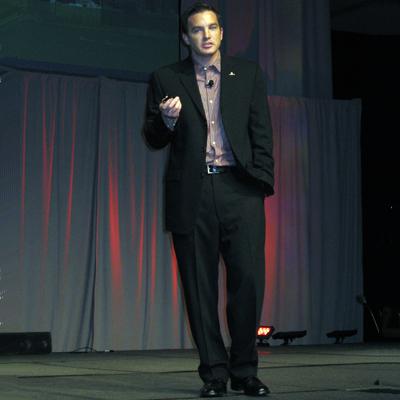
Day Two of the conference started out with Ryan Grant, director of channel marketing at Ingram Micro, introducing new branding initiatives, a new Web portal, and new literature aimed at helping VTN members improve sales.
He also introduced a contest under which three VTN members can win a complete "Extreme Makeover Marketing Edition" from Ingram Micro Creative Services.
Grant also told VTN members to spread the word about successes they have in partnering with fellow members. "It's very important for us that we show VTN members being successful," he said. "It's more important for VTN members to show how they are successful."

Solution providers who start looking for "green" opportunities will find that helping customers cut power consumption is a recipe for success, said Patrick Ciccarelli, president and CEO of Varsity Technologies, a San Francisco-based solution provider.
Ciccarelli said that regardless of how a solution provider feels about the topic, the fact is customers are talking about "green IT."
"It doesn't matter where you are on issues on energy or climate change," he said. "The fact is, it's impacting all of us, and it's impacting our customers."
To reach customers, solution providers have to avoid the six sins of "green washing," which he said is anything less than being committed to helping customers with their green IT requirements.
They include talking about hidden trade-offs for green IT, offering no proof that it is necessary, being vague about what it means, not understanding the relevance of it, choosing it as the lesser of two evils, and fibbing about it.
Ciccarelli also talked about two requirements for moving beyond green IT:
"The first is that a solution provider must define its own corporate values, and not the value of any particular employee. And the second is to assess clients needs for saving energy without going too far towards ecological issues."
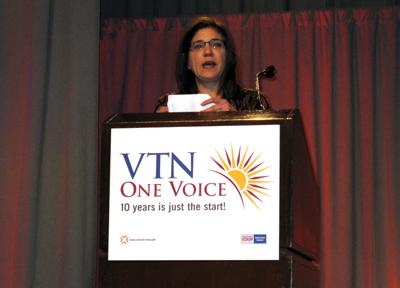
The SMB market is the fastest-growing market for Hewlett-Packard, growing at between 6 percent and 7 percent per year, with the company reaching those customers through partners, said Ramona Thibeault, vice president of SMB sales at HP.
HP is in the process of developing an SMB elite status of partner, with the training and certifications to go with the level, Thibeault said. The new level was expected to be ready in November, but HP is still finishing the analytics for it, she said. However, she did say that an SMB elite partner which grows its business by 10 percent could expect 20 percent more in benefits.
Thibeault said that HP is offering a number of exclusive benefits to VTN members, including new funds for HP sales and technical training from November 1 to January 31, a free HP OfficeJet Pro printer to the 15 partners with the biggest percentage business growth, and a $200 rebate on sales of HP Blade System c7000 servers through November 30.
HP also put in place a new rebate of 50 percent of up to $250,000 in hardware purchased for small and midsize businesses who purchase $800,000 in IT solutions, she said. This program expires on December 31.
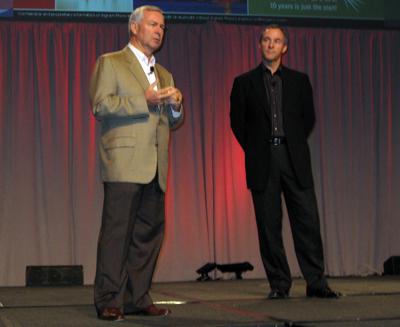
Ingram Micro's two top execs then took the stage to talk about the economy and how it might impact the channel.
Greg Spierkel, CEO (right), said he is not sure the U.S. will go into a recession, but the economy will be soft. He also expects consumer spending down due to the credit crunch, and that home prices and travel will both continue to decline. Unemployment, he said, will probably rise an addition 1.0 percent to 1.5 percent.
However, he said, IT spending for now is holding its own, and he sees little pullback in the channel.
Alain Monie, president and COO of Ingram Micro (left), said that as the economy gets tighter, visibility into the economy gets more difficult. Therefore, solution providers need to watch their costs while at the same time look for new opportunities.
Ingram Micro is sitting on a strong balance sheet and a good pile of cash which will help it should it need to borrow money, Spierkel said. "Being efficient is the most important thing now," he said.
Monie said it is difficult to judge the impact of tighter credit on Ingram Micro and its VTN partners, but the distributor has people and resources to help partners who need access to liquidity, as well as management skills to help partners work with partners who are demanding early payments.
In the end, Monie said, it's important to react to the direction of change, and not to the current state of the market.
"Why do people spend on IT?" he said. "It's not for entertainment, except for a few of you. It's for efficiency and productivity. That's even more important with what's going on in the market today."
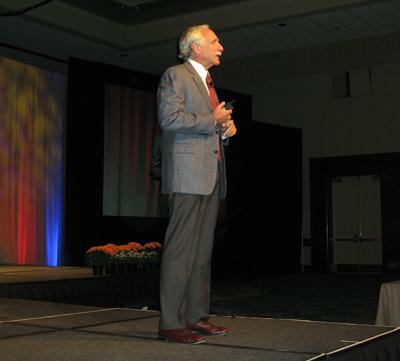
Solution providers account for 100 percent of IBM's SMB hardware sales, said Harris Warsaw, vice president of general business in the Americas for IBM.
Three years ago, the midmarket business floated under IBM's radar screen, but IBM now recognizes that this part of the market is where growth is happening, Warsaw said.
It is also where IBM saw huge gaps in its business, which was traditionally focused on the enterprise, Warsaw said.
"So we came to you and asked you to work with IBM, not because we want another partner tick mark," he said. "It's because we have a gap in sales."
Warsaw admitted that IBM, because of its size, has had issues reaching into the small business and midrange markets.
"Three years ago, I said, 'If the phone's not ringing, it's us,'" he said. "Now the phone is ringing. It's us. We need your help."
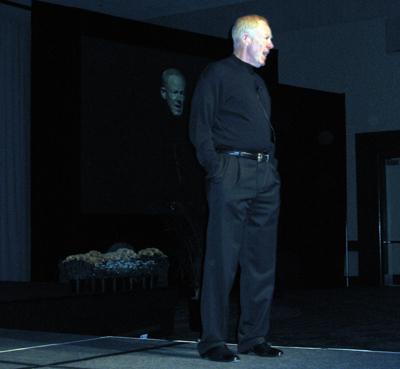
The highlight of the entire day was a speech from Captain Charlie Plumb, a former Navy fighter pilot and POW. during the Vietnam War who received a standing ovation after comparing his prison to the mental prison everyone builds in their own minds.
Plumb, who spent six years in an 8-foot x 8-foot cell, started out on a dark stage pacing three steps back and forth across an 8-foot-wide walkway.
"I could pace three steps before I ran into a wall," he said. "Then I had the opportunity to turn around and look at the other wall. For 2,103 days, I had nothing to do. No books, no TV, no iPod, not even a pencil."
Plumb said he was at the VTN conference to invite the audience into his cell. "The same challenges you face every day are the same I faced in this prison cell," he said. "The responses you make are the same I made."
After a while, Plumb said that he, like most people who have built a prison in their mind, got used to it.
"In fact, after a while, the restriction is not the eight feet between the walls," he said. "It's the eight inches between your ears. A lot of people are stuck in their box, in their mental prison."
Plum said that after he returned to the U.S., he met the person who packed the very parachute that saved his life when his plan was shot down on his 75th mission. "Big fighter jock, flying up there, didn't care about the people down in the hold," he said.
However, he said everyone has someone who packs their parachutes, and typically don't appreciate them. People such as his coach at the Naval Academy or his Naval commander, he said. "They empowered me to win," he said. "They empowered me to fail. They empowered me to make the choice."
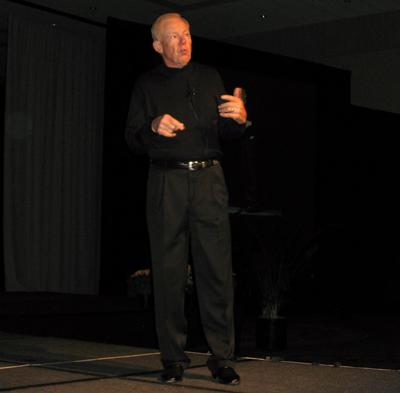
Plumb used to think he flew 74 successful missions and one unsuccessful mission in F-4 Phantom jets, but that he now knows the last was his most successful.
"I was bullet-proof," he said. "Last year, were you bullet-proof? Did you feel bullet-proof when your best tech left you? Did you feel bullet-proof when you got a divorce? You were cocky."
It is those challenges that makes people successful, Plumb said. "Here's a secret," he said. "There's a great deal to be said about getting blown out of the sky once in a while."
When Plumb was first shot down, the first thing he did was start counting the number of panels in his chute. "It's called, assessing your risk," he said. "Then I looked down and was seeing people shooting at me. When you are dodging bullets, it's hard to make long-term plans."
Plumb's first challenge was reaching out to his fellow captives, all of whom were kept in isolated cells. He recalled hearing a slight shuffling noise on the floor, and looking for it for some time until he saw a piece of wire moving in a corner.
Eventually he realized that someone was moving that piece of wire using Morse Code, trying to establish contact. However, he said, he did not answer for a long time for fear it was the enemy. He said it is similar to how solution providers fear reaching out to others for help.
Everyone is a product of the challenges they face and they choices they make, Plumb said. "Adversity is a horrible thing to waste," he said.
In the end, Plumb finished by asking how his life and the lives of the audience met on that particular day. "You'll never be prisoners of war. You'll never face those 8-foot walls. But you will face those eight inches here," he said, holding his hands on either side of his head.
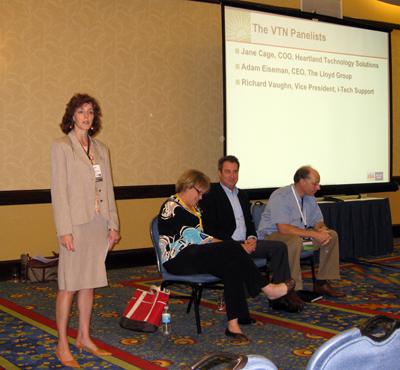
Heather Clancy, vice president of strategic communications at the SWOT Management Group and former editor of CRN, led a panel of three solution providers who discussed how to take advantage of Web 2.0 in their marketing.
Clancy (standing, on left) defined Web 2.0 as applications that allow people to collaborate more easily. Those applications exist in the cloud, often in the form of a private community.
Jane Cage, COO of Heartland Technology Solutions, Joplin, Missouri (seated on left), said that she got into Web 2.0 as a way to see what her younger employees are doing and whether their personal sites impacted her business.
"I wanted to make sure that if someone searched us, they don't think we're some drunken party place," she said.
Cage said she uses MySpace to keep up on close relationships, and LinkedIn to keep track of business acquaintances. Her company also uses Microsoft's InfoPath to allow colleagues to collaborate on scoping documents, and Microsoft's Meeting Workspace to keep meeting notes.
Adam Eiseman, CEO of the Lloyd Group, New York (seated center), said he has closed business and hired personnel using FaceBook. One customer was found through FaceBook because Eiseman and the customer discovered they share a passion for cars, he said.
The Lloyd Group uses SharePoint for internal documents including those for human resources, Eiseman said. It also uses social networking to manage an alumni group of former employees. It has even started reaching out to 20-something potential employees with YouTube, he said.
i-Tech Support, Maitland, Fla., often engages with customers using blogs before reaching out to each other, said Richard Vaughn, vice president (right).
"We use social networking to build a list of people we're interested in working with," Vaughn said. "We then write a blog, and send a message to the list telling them what we are talking about and asking them to comment."
i-Tech has also gotten referrals and has built potential client lists using LinkedIn, Vaughn said.